|
MAIN PAGE
> Back to contents
Litera
Reference:
Povalko P., Zhang J., Wang Z.
Written Ñommunication in Chinese on the International University Ñampus
// Litera.
2023. ¹ 10.
P. 11-32.
DOI: 10.25136/2409-8698.2023.10.44083 EDN: YZCZHT URL: https://en.nbpublish.com/library_read_article.php?id=44083
Written Ñommunication in Chinese on the International University Ñampus
Povalko Polina
ORCID: 0000-0002-4278-3408
PhD in Philology
Senior lecturer, General and Russian Linguistics Department, Peoples' Friendship University of Russia named after Patrice Lumumba (RUDN University)
117198, Russia, Moscow, Miklukho-Maklaya str., 6

|
povalko-pyu@rudn.ru
|
|
 |
Chzhan Jiaxian
Student, Department of General and Russian Linguistics, Peoples' Friendship University of Russia named after Patrice Lumumba (RUDN University)
117198, Russia, Moscow, Miklukho-Maklaya str., 6

|
1032229207@rudn.ru
|
|
 |
|
Van Chzhiin
Student, Department of General and Russian Linguistics, Peoples' Friendship University of Russia named after Patrice Lumumba (RUDN University)
117198, Russia, Moscow, Miklukho-Maklaya str., 6

|
1032229599@rudn.ru
|
|
 |
|
DOI: 10.25136/2409-8698.2023.10.44083
EDN: YZCZHT
Received:
20-09-2023
Published:
05-10-2023
Abstract:
The article examines the place and role of the Chinese language in the linguistic landscape of the campus of the Peoples' Friendship University of Russia named after Patrice Lumumba. The subject of the study is written public texts in Chinese, posted on the university campus (announcements, signs, posters, etc.). The material collected by the continuous sampling method was analyzed from the positions of the addressees of the texts, their subject matter and multilingualism, and also evaluated from the point of view of compliance with the norms of the Chinese language in the texts. The effectiveness of Chinese-language written communication was assessed using a survey of Chinese-speaking students. The place of the Chinese language in the linguistic landscape of the university campus is described; it is noted that written communication in Chinese on campus plays an important role both in the educational process and in everyday interaction. At the same time, conclusions about the insufficient representation and limited thematic diversity of Chinese-language texts were drawn. Recommendations for improving written communication in Chinese are proposed, which will help optimize the process of adaptation of students from China, increase their awareness, which will generally have a positive impact on the ergonomics of the communicative space, as well as increase the status of the Chinese language in the language landscape of an internationally oriented university.
Keywords:
international campus, university campus, linguistic landscape, written communication, communicative space, intercultural communication, internationally oriented university, ergonomics of the communicative space, multilanguage, Chinese language
This article is automatically translated.
You can find original text of the article here.
Introduction Patrice Lumumba Peoples' Friendship University of Russia (RUDN) has students from more than 160 countries who are native speakers of various linguistic cultures, which makes the university campus a multilingual multicultural space with a unique language landscape. On the campus, in addition to Russian as the state language of the Russian Federation and the official language of education, foreign languages function: English, French, Arabic, Spanish, Persian, Chinese, etc. According to the official website, about 11 thousand foreigners study at the RUDN, almost 1100 of them are students from China, which is 10% of the total number. Therefore, the Chinese language is one of the important components of the communicative space of the international campus of the RUDN, and its appearance in the linguistic landscape of the university can be assessed from the standpoint of "the status of the language, demographic and institutional power of the ethnos" [1:27], as well as its "strength, power, status, significance and viability in this territory" [2:301]. The role of a separate language in the formation of a multilingual language landscape has been studied by both foreign and domestic scientists. We note the works of A. Pavlenko [3] and J. Jenkins, A. Mauranen (J. Jenkins, A. Mauranen) [4], which provide a methodological basis for such studies, as well as the works of Russian and Chinese scientists devoted to the study of the role of the Chinese language in the linguistic landscapes of cities [5, 6, 7, 8, 9, 10 etc.] and educational institutions [11, 12, 13, 14, 15, etc.]. It is established that the use of Chinese in a foreign language communicative space helps Chinese students to preserve and express their identity, emphasizes the social activity of the Chinese language community, demonstrates its status in the study area. This article will explore written communication in Chinese, represented by visual public texts: ads, signs, posters, inscriptions, etc. It should be noted that this issue is one of the tasks being solved within the framework of a multidimensional research project on the study of the linguistic landscape of the campus of the International University, which is being implemented at the Department of General and Russian Linguistics of the Philological Faculty of the Patrice Lumumba Peoples' Friendship University of Russia [16; 17]. The purpose of this study is to identify the features of written communication in Chinese in the communicative space of an international university on the example of the RUDN campus. To achieve this goal, all texts in Chinese or using it, "located outside or inside a public institution" [18:14], that is, the objects of the RUDN campus, were collected by a continuous sampling method. The collected material was analyzed from the positions of the addressees of the texts, subject matter and multilingualism; in addition, the texts of the ads were studied and evaluated from the point of view of the correctness of their translation in compliance with all the norms of the Chinese language. In addition, a survey of students who speak Chinese was conducted to assess the effectiveness of written Chinese-language communication. The results obtained can contribute to the study of the language landscape of the campus of an international university (RUDN), to research on intercultural communication in Russian universities and to the practice of teaching Russian as a foreign language to Chinese students. Results On the territory of the RUDN campus, ads in Chinese are much less common than in Russian and English (41 texts were found), since such ads are targeted at a certain circle of information recipients — native Chinese speakers and students of Chinese as a foreign language. It is known that the choice of a particular language in public texts is carried out in order to reach a certain audience and exclude another [19]. Classifieds in Chinese are classified according to the following parameters: addressee (official or unofficial text); subject matter; multilingualism / monolingualism. In addition, the completeness and quality of the translation of the text into Chinese were evaluated. The creators of the language landscape, or addressees of texts, stand out as its key characteristic [18; 20]. Thus, researchers classify public texts as "top-down", i.e. established by the authorities, and as "bottom-up", i.e. established by private individuals [18]. In the educational context, we can talk about texts created by the university administration, and about texts addressed by teachers and students of the RUDN. As the research material showed, all ads in Chinese are created by the university administration. In addition, texts were found whose addressees were external entities in relation to the RUDN, such ads are mainly of an advertising nature. According to the content, all announcements in Chinese on campus can be divided into 5 groups: announcements about safety rules, advertisements, invitations, informational announcements and requests. All announcements about security measures (see Fig.1, Fig. 2) in Chinese are posted on the floors of the dormitory. In addition, you can see an evacuation sign in Chinese "", that is, "emergency exit indicator" (see Figure 3), located in the academic building of the Faculties of Natural Sciences and Humanities (EGF), at the Institute of the Russian Language, the Institute of Foreign Languages, etc. It is worth noting that such ads are always placed not separately, but in parallel with ads in other languages, such as French, Spanish and Arabic, which forms a multilingual picture. 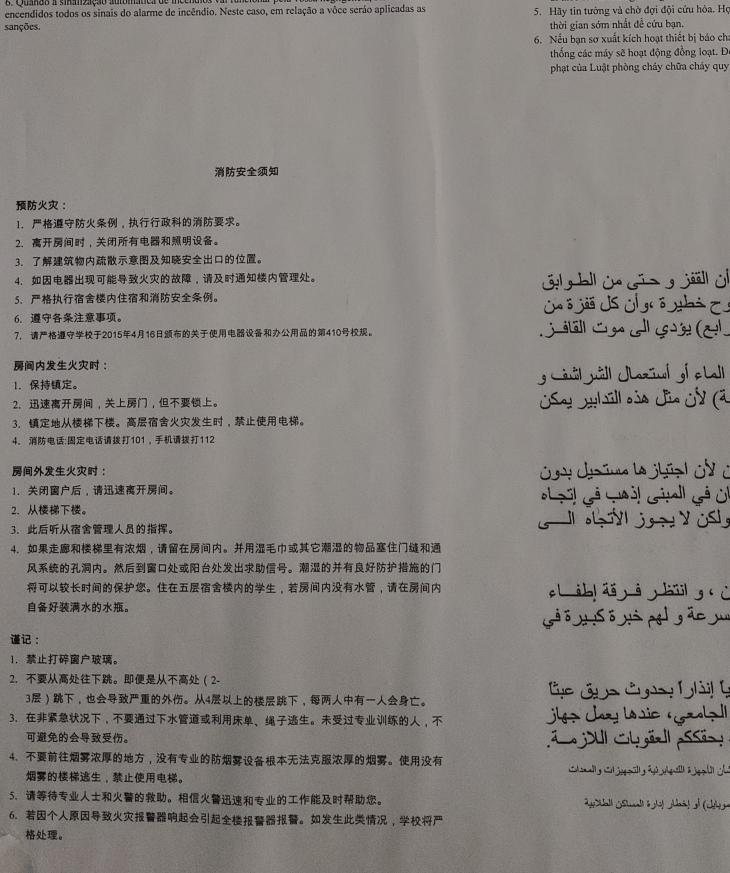 Fig. 1 Fig. 1 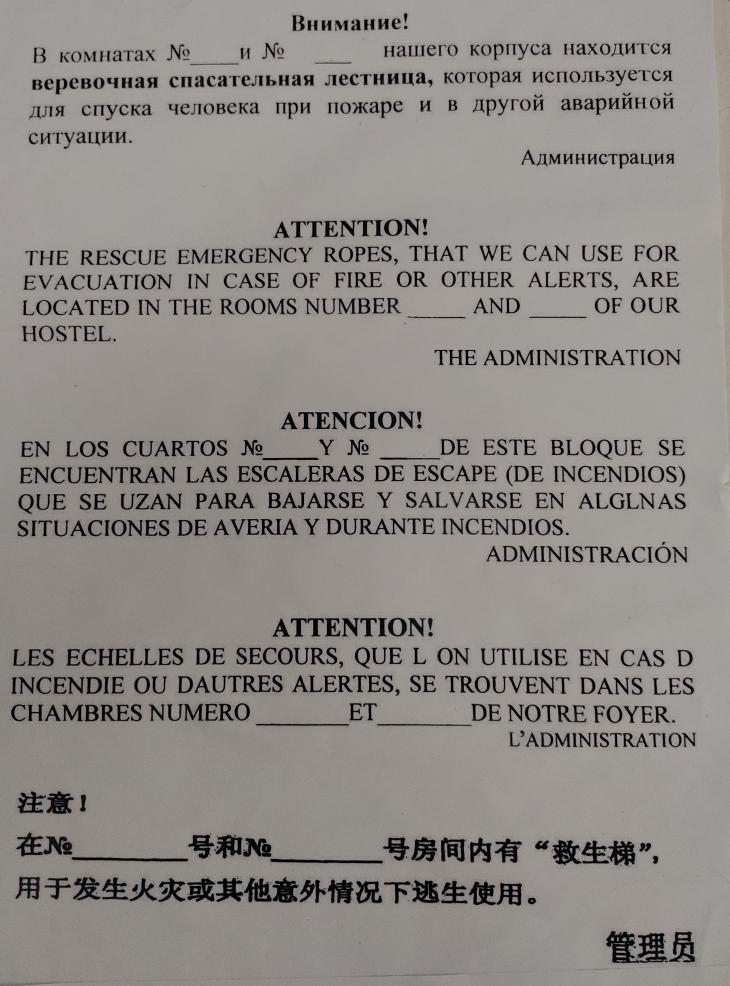
Fig. 2 Fig. 2 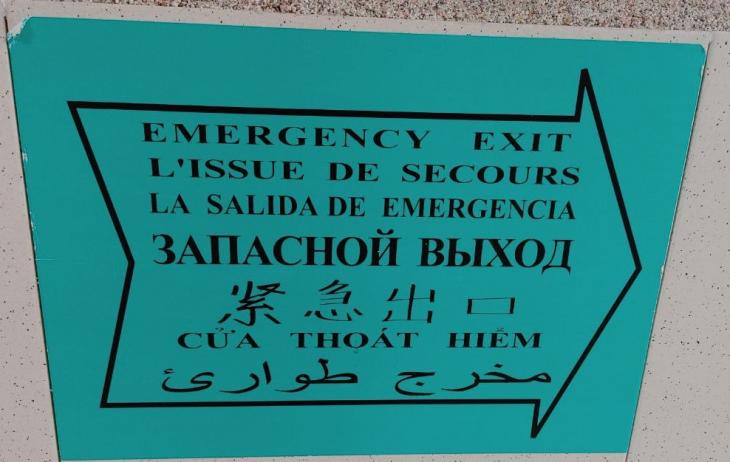
Fig. 3 Fig. 3 
Fig. 4 Fig. 4 Russian Russian As for advertisements, only two such ads were found on the RUDN campus: one — on the registration of notarized translation of documents from Chinese into Russian — is located on the basement floor of the EGF building (see Figure 5), the other — on the provision of assistance in studying and admission to universities in Russia — at the preparatory faculty of the Institute of Russian language (see Fig. 4). 
Fig. 5 Fig. 5 As well as announcements about safety rules, the advertisement of the notary office division on the ground floor of the EGF building contains text in several languages at the same time, including "notarial translation of documents" in Chinese. In the first case, multilingualism is due to a vital necessity: an announcement written in the students' native language allows them to quickly and correctly take measures to ensure safety in an emergency situation. In the second case, multilingual advertising is aimed at a wider range of potential customers — native speakers of different languages, including Chinese. Announcements about the working hours are usually placed on the doors of the offices, but most of them are written in Russian, the announcement of the working hours in Chinese is found only on the door of the office "Department of Asian Countries" (see Fig. 6), where Asian students' documents are accepted for admission to the RUDN. In addition, the group of informational announcements includes an announcement about the method of contact with the Asian Countries Department in the EGF building (see Figure 7), an announcement about the state of the Chinese language in the world (see Figure 8) and a map of China in Chinese at the Institute of Foreign Languages (see Figure. 9), as well as a memo on separate garbage collection in dormitory No. 11 (see Fig. 10; 10.1). 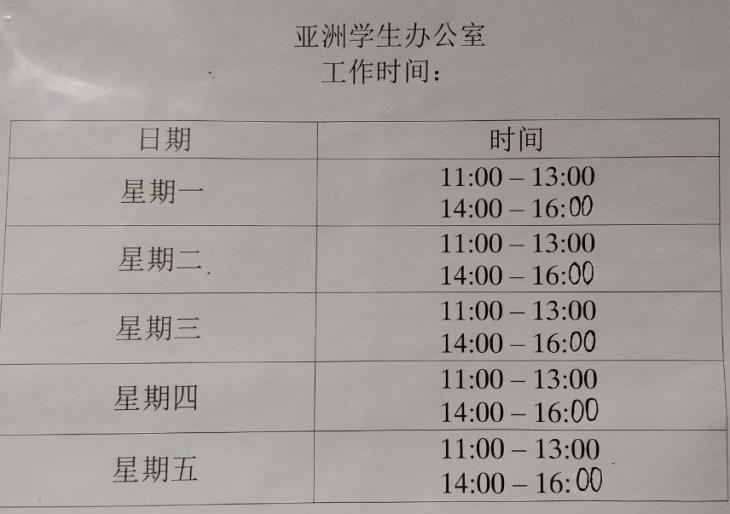
Fig. 6 Fig. 6 
Fig. 7 Fig. 7 
Fig. 8 Fig. 8 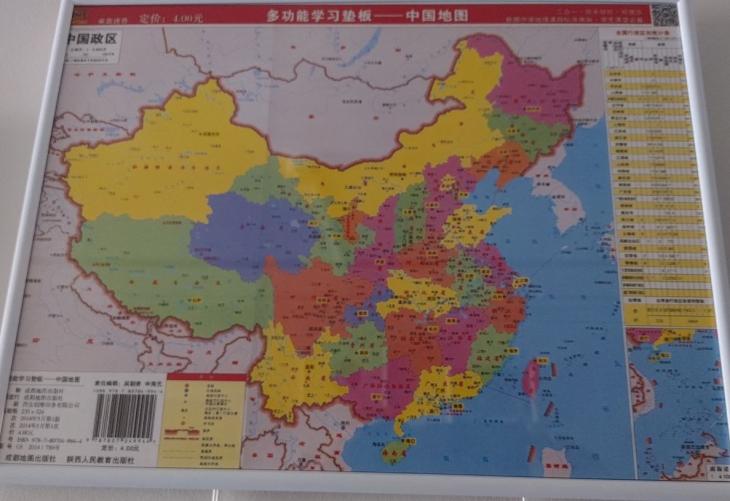
Fig. 9 Fig. 9 
Fig. 10 Fig. 10

Figure 10.1
Fig. 10.1
It should be noted that the announcement of the state of the Chinese language and the memo on garbage sorting are equally characterized by polylingualism. In addition, it is obvious that the text of the second ad was not composed by native Chinese speakers, since there are expressions in it that do not correspond to the spelling rules of the Chinese language. For example, the phrase administration of the building is translated into Chinese as , while the correct expression is ? ?.. The text contains solecism (,,)?/,, and the best translation from Russian into Chinese should be: (,,)?, ("... in the corridors/kitchens hostel set blue containers for the collection of recyclables (plastic, glass, metal), and in the halls of hostels containers yellow for waste paper"). It should be noted that the method of literal translation without taking into account the context was applied to this phrase. The word containers in this context should be translated as , that is, ‘containers specially designed for garbage collection’, and not as , denoting containers of various purposes, which causes a distortion of the meaning. It is also necessary to make corrections to the last sentence of the ad — "" — in this context, the use of the passive voice and the translation of the adverb is still in Chinese as ? does not correspond to the language practice of native Chinese speakers. In this case, we consider the following translation option to be correct: " ". Let's move on to discussing the invitation announcements. Similar texts in Chinese are found on a limited campus – at the Institute of the Russian Language and the Institute of Foreign Languages, since most of the Chinese students study there, as well as students studying Chinese as a foreign language. It should be noted that some of these invitations contain translation inaccuracies. According to the typological classification, the Chinese language belongs to the isolating type of languages, which are characterized by the absence of inflection and a high degree of conciseness. This fact must be taken into account when translating: there are several extra hieroglyphs in these ads — for a clearer and briefer transmission of information, they should be removed. As an example, here is the text of the invitation to participate in volunteer activities (see Fig. 11), hosted by the Institute of the Russian Language. The title of the text """ contains two extra elements: the service word and the qualitative adjective. Firstly, the presence of the service word in this text is not necessary; secondly, in Chinese it is not customary to say "" ("make good friends"). The available options in this case are the expressions "" ("make friends") and "" ("make good friends"). The verbs (to make) and (to make) differ in appearance: in the first variant, the emphasis is on the action itself, in the second — on the result of the action, in other words, on the quality of friends. In addition, the phrase "" is a grammatically incorrect sentence with three extra hieroglyphs: the first, the second, and the second. The correct way to accurately express the meaning of this phrase is: "".
In addition to the use of extra hieroglyphs, the lexical compatibility is violated in the ad: "" ("tell me about yourself fully"). To correct this error, it is necessary to replace the adverb (fully) with the word (in detail). In addition, the text of the invitation ends with an incomplete sentence "You will meet". This ad differs from others by the incompleteness of the text content. 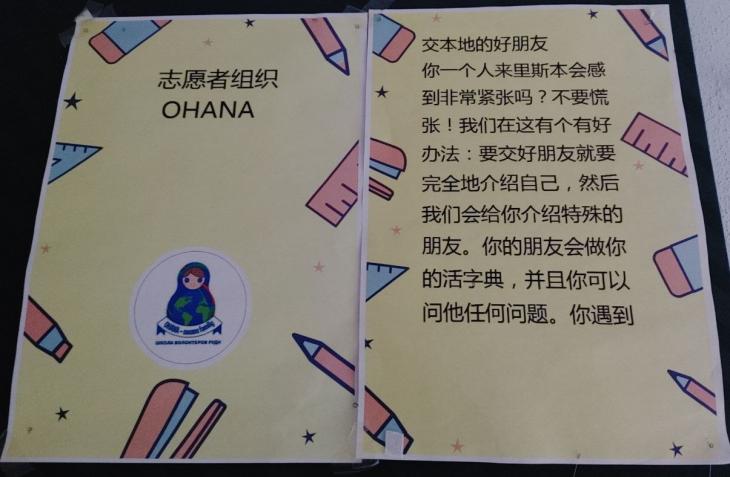
Fig. 11 Fig. 11 
Fig. 12 Fig. 12 On the first floor of the Institute of Foreign Languages there is a request to hand over outerwear to the wardrobe in seven languages, including Chinese (see Fig. 12). Russian Russian version of "" ("Take off your outerwear and put it in storage") omitted an appeal to visitors and a place to put clothes in, which to a certain extent differs from the original in Russian, compared to the text in Russian "Dear visitors, kindly request to hand over outerwear to the wardrobe". The listed ads in Chinese are related to the organization of students' life and their extracurricular life, while we have not found any texts related to the educational process. One of the features of Chinese-language texts is that the content of ads is transmitted in a simple verbal form without special design or decorative elements. At the same time, as it was found during the study of the ergonomics of the communicative space of the RUDN campus [21], the use of images, large font and bright colors attracts the attention of students and encourages them to read the ad. In order to find out what is the attitude towards Chinese-language written communication on the part of its potential addressees, and to establish to what extent they are satisfied with the quantity and quality of information in Chinese on the campus of RUDN, a survey of students with knowledge of Chinese was conducted. 57 respondents took part in the survey conducted using Google.Forms. The questions were compiled taking into account the need to solve several specific tasks: - establish the ratio of respondent types (native Chinese speakers / Chinese language learners); - to find out how respondents estimate the level of prevalence of ads in Chinese on the campus of the RUDN; - to find out to what extent respondents have a desire to read the ads they have seen in Chinese; - to determine how satisfied the survey participants are with the quantity and quality of the translation of ad texts into Chinese; - find out the opinions of respondents about the need to increase the number of ads in Chinese; - identify the types of ads that are most interesting to informants. According to the results, 82.5% of the survey participants are native Chinese speakers, the rest study Chinese as a foreign language (see Figure 13). 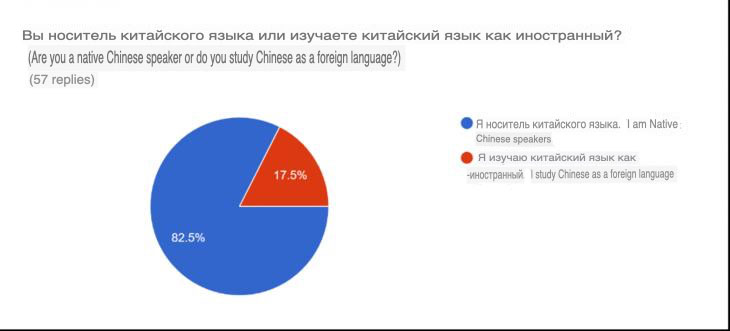
Fig. 13. Types of respondents Fig. 13. Types of respondents To the question "Have you seen ads in Chinese on the RUDN campus?" three possible answers were provided: "Yes, I often encounter ads in Chinese", "I have seen (a), but there are few such ads" and "I have never seen(a) ads in Chinese." It should be noted that among 57 respondents, no one chose the first option, which is explained by the fact that ads in Chinese on the RUDN campus are limited to the scope of distribution, as mentioned above (see Figure 14). The majority of respondents (82.5%) estimated the prevalence of texts in Chinese as low. 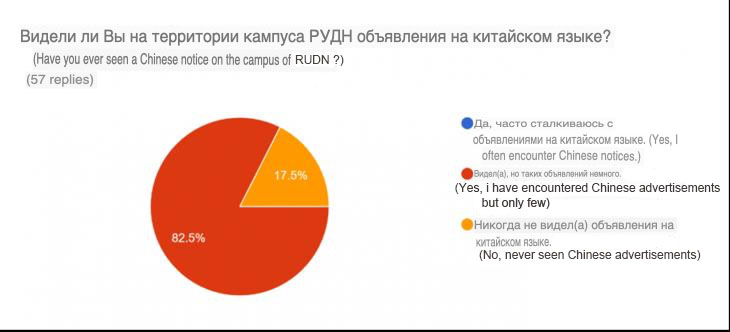
Figure 14. Assessment of the prevalence of Chinese-language ads on the RUDN campus
Fig. 14. Assessment of the prevalence of Chinese texts on the RUDN campus More than 80% of the survey participants expressed dissatisfaction with the available number of ads in Chinese (see Fig. 15); the number of respondents supporting an increase in the number of such ads is 75.4% (see Figure 16). 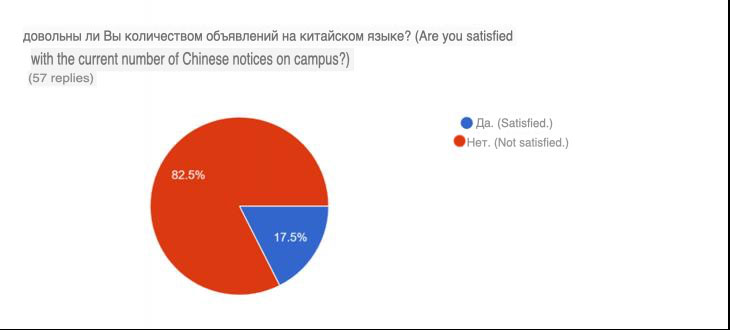
Figure 15. The level of satisfaction of survey participants with the quantity and quality of translation of ad texts Fig. 15. Level of satisfaction of respondents with the quantity and quality of translation of texts 
Figure 16. Opinion of respondents on the need to increase the number of ads in Chinese Fig. 16. Opinion of respondents on the need to increase the number of Chinese texts In addition, based on the collected data, more than 98% of respondents indicated a desire to read the ad they saw in Chinese, and 59.6% of them read the texts of these ads selectively (see Figure 17). It should be noted that, despite the high degree of desire of the survey participants to read the ads they saw in Chinese, the quality of their translation causes dissatisfaction among 84.2% of respondents (see Figure 18). 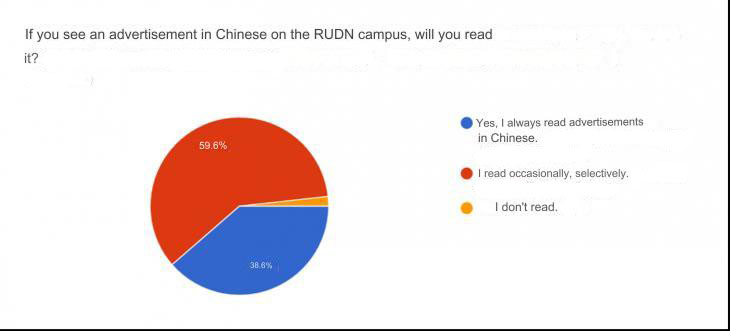
Figure 17. The desire to read the ads seen in Chinese Fig. 17. Desire to read Chinese texts on the campus 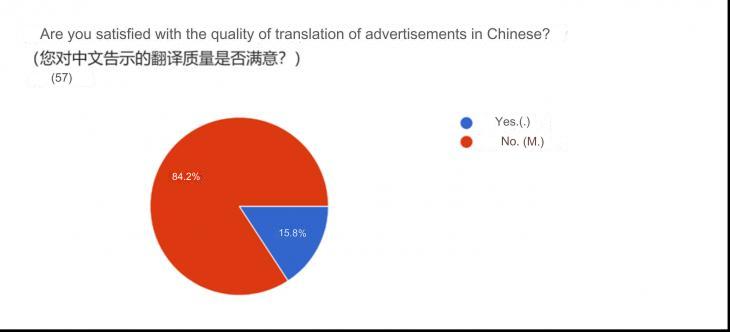
Figure 18. The level of satisfaction of survey participants with the quantity and quality of translation of ad texts Fig. 18. Level of satisfaction of respondents with the quantity and quality of translation of texts We also classified all ads posted on the RUDN campus in Chinese, dividing them into 5 groups, and asked participants to choose the types of ads that attract their attention. The majority of respondents show more interest in announcements about security rules and announcements of an informational nature (see Figure 19). 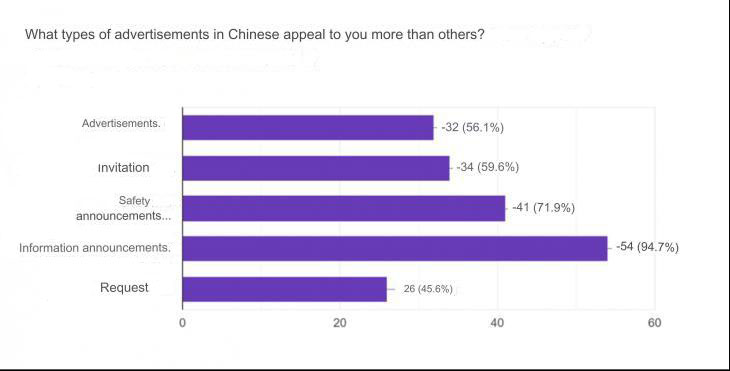
Figure 19. Types of ads that informants are interested in Fig. 19. Types of texts that informants are interested in The survey results revealed opportunities for improving the effectiveness of written intercultural communication on the RUDN campus by eliminating a number of existing problems, such as an insufficient number of ads in Chinese, a narrow range of their distribution and inaccuracy of translation of content. Conclusion In this article, the texts in Chinese placed on the campus of the Patrice Lumumba Peoples' Friendship University of Russia were analyzed. The conducted research allows us to conclude that written communication in Chinese on the campus of an international university plays an important role both in the educational process and in everyday interaction. Texts in their native language allow students from China, especially those who speak Russian at an insufficient level, to receive the necessary information concerning important areas of life, help them adapt to a foreign cultural environment. However, there are opportunities to improve the quality of written Chinese—language communication on campus, which means to improve the ergonomics of the communication space. In particular, it is necessary to increase the quantitative and thematic representation of texts in Chinese. For example, in order to help students, especially applicants, adapt to the new cultural environment and familiarize themselves with the educational system of the Russian Federation, it is necessary to increase the number of ads in Chinese, the content of which should be related to topics such as the condition for obtaining a red diploma of Russian universities, mandatory formalities after arrival in Russia, etc.
References
1. Landry, R., & Bourhis, R. (1997). Linguistics Landscapes and Ethnolinguistic Vitality: An Empirical Study. Journal of Language and Social Psychology, 16(1), 23–49. doi:10.1177/0261927X970161002
2. Pütz, M. (2020). Exploring the linguistic landscape of Cameroon: Reflections on language policy and ideology. Russian Journal of Linguistics, 24(2), 294–324. doi:10.22363/2687-0088-2020-24-2-294-324
3. Pavlenko, A. (2017) Linguistic Landscape and other Sociolinguistic Methods in the Study of Russian Language Abroad. Russian Journal of Linguistics, 21(3), 493-514. doi:10.22363/2312- 9182-2017-21-2-493-514
4. Jenkins., J., & Mauranen, A. (eds.) Linguistic Diversity on the EMI Campus: Insider accounts of the use of English and other languages in universities within Asia, Australasia, and Europe (1st ed.). Routledge, 2019. doi:10.4324/9780429020865
5. Dubinina, M. N., & Kolodiazhnaia, D. A. (2021). The Chinese Component in Linguistic Landscape of Kolomna’s Cultural and Historical Part. Philology. Theory & Practice, 14(4), 1213–1217. doi:10.30853/phil210189
6. Liu, J. (2019). Linguistic Landscape: research and analysis of translations from Russian into Chinese in major Russian cities. Vestnik of Lomonosov Moscow State University, Ep. 22, Translation theory, 2, 121–129.
7. Cao, H.Z., Liu, Y.Q., & Chen, H.Y. (2022). Mapping the Linguistic Landscape in a Chinese University. Open Access Library Journal, 9, 1–16. doi:10.4236/oalib.1109585
8. Xiaofang, Y. A. (2020). A layered investigation of Chinese in the linguistic landscape: A case study of Box Hill, Melbourne. Australian Review of Applied Linguistics, 43(3), 302-336. doi:10.1075/aral.18049.yao
9. Lyu Lu. (2021). Sposoby i motivy naimenovaniya geografi cheskikh ob’’yek-tov v kitayskom i russkom yazykakh = Methods and motives of geographical objects naming in Chinese and Russian. Litera, 5, 97–105 (In Russian). doi:10.25136/2409-8698.2021.5.35607
10. Yaru Zhou, & Yi Zhang (2023). The Role of Linguistic Landscape in Teaching Chinese as a ForeignLanguage: Taking theLinguistic Landscape in Lanzhou Subway Stationasan Example. Journal of Social Science Humanities and Literature, 6(4), 201-212. doi:https://doi.org/10.53469/jsshl.2023.06(04).38
11. Im, J.H. (2020). The discursive construction of East Asian identities in an era of globalization and internationalization: the linguistic landscape of East Asian departments at a US university. Journal of Multicultural Discourses, 15(1), 80–103. doi:10.1080/17447143.2020.1738441
12. Liu, C., & Wang, Y. J. (2021). Exploration of Code Use and Arrangement of Linguistic Landscape in Universities-Take Shungeng Campus of Shan Dong University of Finance and Economics as an example. Modern Communication, 20, 102–104.
13. Zhang, Y.C. (2020). Research on the Linguistic Landscape of University Campus. Literature Education, 10, 132–133. doi:10.16692/j.cnki.wxjys.2020.10.058.
14. Jiang, S., & Ma, C.Y. (2018). Research on the Linguistic Landscape of University Campus from the Perspective of Adaptation Theory. Ability and Wisdom, 09, 13-114. doi:https://kns.cnki.net/kcms/detail/detail.aspx?FileName=CAIZ201809011&DbName=CJFQ2018.
15. Nosiani, N., Asiyah, S., & Mustikawati, D.A. (2019). Linguistic Landscape on Campus in Ponorogo (A Case Study of Sings in Ponorogo Universities). EDUPEDIA, 3(2), 130–138. doi:10.24269/ed.v3i2.299
16. Povalko, P.Yu., Mikheeva, Å.S., & Gubanova, Î.I. (2022). University campus as the subject of scientific research. Language as Art: functional Semantics and Poetics: collection of articles of the International Scientific and Practical Conference. Moscow, RUDN University, 283-291. Retrieved from https://elibrary.ru/item.asp?id=49717277
17. Kolysheva O.N., Lokhankina I.N., & Taranova A.A. (2022). What does the word «campus» mean: the view of students and professors. Language as Art: functional Semantics and Poetics: collection of articles of the International Scientific and Practical Conference. Moscow, RUDN University, 616-623. Retrieved from https://www.researchgate.net/publication/364939471_What_does_the_word_campus_mean_the_view_of_students_and_professors_Cto_znacit_slovo_kampus_vzglad_studentov_i_prepodavatelej
18. Ben-Rafael, E., Shohamy, E., Amara, M. H. & Trumper-Hecht, N. (2006). Linguistic Landscape as symbolic construction of the public space: the case of Israel. International Journal of Multilingualism, 3(1), 7–30. doi:10.1080/14790710608668383
19. Cenoz, J., & Gorter, D. (2006). Linguistic landscape and minority languages. International Journal of Multilingualism, 3, 67–80. doi:10.1080/14790710608668386
20. Malinowski, D. (2009). Authorship in the linguistic landscape: A multimodal-performative view. In Shohamy, E. & D. Gorter (eds.) Linguistic landscape: Expanding the scenery. New York/ London: Routledge, 107-125.
21. Gubanova, O.I., & Lokhankina, I.N. (2022). Ergonomics of the communicative space of the international campus: the view of international students. Oriental Kaleidoscope: materials of reports and reports of the III All-Russian Scientific and Practical Conference of Young Orientalists with international participation. Moscow, RUDN University, 136-144.
Peer Review
Peer reviewers' evaluations remain confidential and are not disclosed to the public. Only external reviews, authorized for publication by the article's author(s), are made public. Typically, these final reviews are conducted after the manuscript's revision. Adhering to our double-blind review policy, the reviewer's identity is kept confidential.
The list of publisher reviewers can be found here.
The reviewed article examines written communication in Chinese, represented by visual public texts: advertisements, signs, posters, inscriptions, etc. The author notes that "this issue is one of the tasks being solved within the framework of a multidimensional research project to study the linguistic landscape of the International University campus, which is being implemented at the Department of General and Russian Linguistics of the Philological Faculty of the Patrice Lumumba Peoples' Friendship University of Russia." Thus, the presented task is quite precisely formulated, the purpose of the study is transparent, relevant, and timely. To achieve this goal, a continuous sampling method was used, all texts in Chinese or using it were collected, "located outside or inside a public institution," that is, the facilities of the RUDN campus. In particular, it is specified that "the collected material was analyzed from the positions of the addressees of the texts, subject matter and multilingualism; in addition, the texts of the ads were studied and evaluated in terms of the correctness of their translation in compliance with all the norms of the Chinese language." The methodology of the analysis of language material is beyond doubt, it has an academic standard. The style of work correlates with the actual scientific type of speech, the material is practical in nature, the developments, in my opinion, can be productively used further. The actual data is sufficient to verify the problem: "on the RUDN campus, ads in Chinese are much less common than in Russian and English (41 texts were found), since such ads are aimed at a certain range of information recipients — native Chinese speakers and students of Chinese as a foreign language. It is known that the choice of a particular language in public texts is carried out in order to reach a certain audience and exclude another." The objective tone of the analysis can be traced throughout the work, and the theoretical basis is connected quite organically and appropriately. For example, "classifieds in Chinese are classified according to the following parameters: addressee (official or unofficial text); subject matter; multilingualism / monolingualism. In addition, the completeness and quality of the translation of the text into Chinese were evaluated." I believe that the work was done at the proper scientific level, the illustrative background is maximum; the pictogram mode allows a potentially interested reader to fully assess the situation of practical written communication in Chinese on the RUDN campus. The actual conclusions are substantive, the author notes that "according to the content, all announcements in Chinese on campus can be divided into 5 groups: announcements about safety rules, advertisements, invitations, informational announcements and requests", "all announcements about security measures (see Fig.1, Fig. 2) in Chinese they are placed on the floors of the dormitory. In addition, you can see an evacuation sign in Chinese "????", that is, "emergency exit sign" (see Figure 3), located in the academic building of the Faculties of Natural Sciences and Humanities (EGF), at the Institute of the Russian Language, the Institute of Foreign Languages, etc. It is worth noting that such ads are always placed not separately, but in parallel with ads in other languages such as French, Spanish and Arabic, which forms a multilingual picture," etc. A proper analytical comment is given correctly: "as for advertisements, only two such ads were found on the RUDN campus: one about Russian Russian translation is located on the ground floor of the EGF building (see Fig. 5), another — on the provision of educational assistance and admission to universities in Russia — at the preparatory faculty of the Institute of the Russian Language (see Fig. 4)", or "announcements about the working hours are usually placed on the doors However, most of them are written in Russian, the announcement of the working hours in Chinese is found only on the door of the office "Department of Asian Countries" (see Fig. 6), where Asian students accept documents for admission to the RUDN. In addition, the group of information announcements includes an announcement about the method of contact with the Asian Countries Department in the EGF building (see Fig. 7), an announcement about the state of the Chinese language in the world..." etc. The language structure of the work is normalized, the so-called communication models support the general logic of analysis: "let's move on to discussing invitation announcements. Similar texts in Chinese are found on a limited campus area – at the Institute of the Russian Language and the Institute of Foreign Languages, since most Chinese students study there, as well as students studying Chinese as a foreign language." It is important that the work contains a critical assessment of the situation, which is important when correcting inaccuracies / shortcomings in fact: "in addition to using unnecessary hieroglyphs, the lexical compatibility is violated in the ad: "??????"" ("tell me about yourself fully"). To correct this error, it is necessary to replace the adverb ??? (fully) with the word ??? (in detail)", or "compared to the text in Russian, "Dear visitors, we kindly ask you to take your outerwear to the wardrobe", in the Chinese version "????????" ("Take off your outerwear and put it in storage"), an appeal is omitted to visitors and a place for putting clothes, which differs to a certain extent from the original in Russian," etc. Thus, the constructive principle of disclosing the problem is available, in fact, this gives the text novelty and relevance. The study is not devoid of statistical data, they support the objectivity of the situation: "according to the results, 82.5% of the survey participants are native Chinese speakers, the rest study Chinese as a foreign language (see Fig. 13)", or "more than 80% of the survey participants expressed dissatisfaction with the available number of ads in Chinese (see Fig. 15); the number of respondents supporting an increase in the number of such ads is 75.4% (see Figure 16)", etc. A fully developed data block is illustrated by graphs and diagrams. In the final section, it is noted that "the conducted research allows us to conclude that written communication in Chinese on the campus of the international university plays an important role both in the educational process and in everyday life interaction. Texts in their native language allow Chinese students, especially those who speak Russian at an insufficient level, to receive the necessary information concerning important areas of life, and help them adapt to a foreign cultural environment. However, there are opportunities to improve the quality of written Chinese—language communication on campus, which means to improve the ergonomics of the communication space." A practical set of recommendations is also appropriate in the final of the work, for example, "in order to help students, especially applicants, adapt to a new cultural environment and familiarize themselves with the educational system of the Russian Federation, it is necessary to increase the number of ads in Chinese, the content of which should be related to topics such as the condition for obtaining a red diploma from Russian universities, mandatory formalities after arrival in Russia, etc.". The topic of the article corresponds to one of the headings of the publication, the list of sources is correct, it is not advisable to expand and supplement the text. The main purpose of the work has been achieved, the structure has been maintained within the framework of scientific research. In my opinion, it is possible to specify the name by introducing a guideline for the traditional nomination of the educational institution – Patrice Lumumba Peoples' Friendship University of Russia. The article "Written communication in Chinese on the campus of an international university" can be recommended for open publication in the scientific journal "Litera".
Link to this article
You can simply select and copy link from below text field.
|
|





